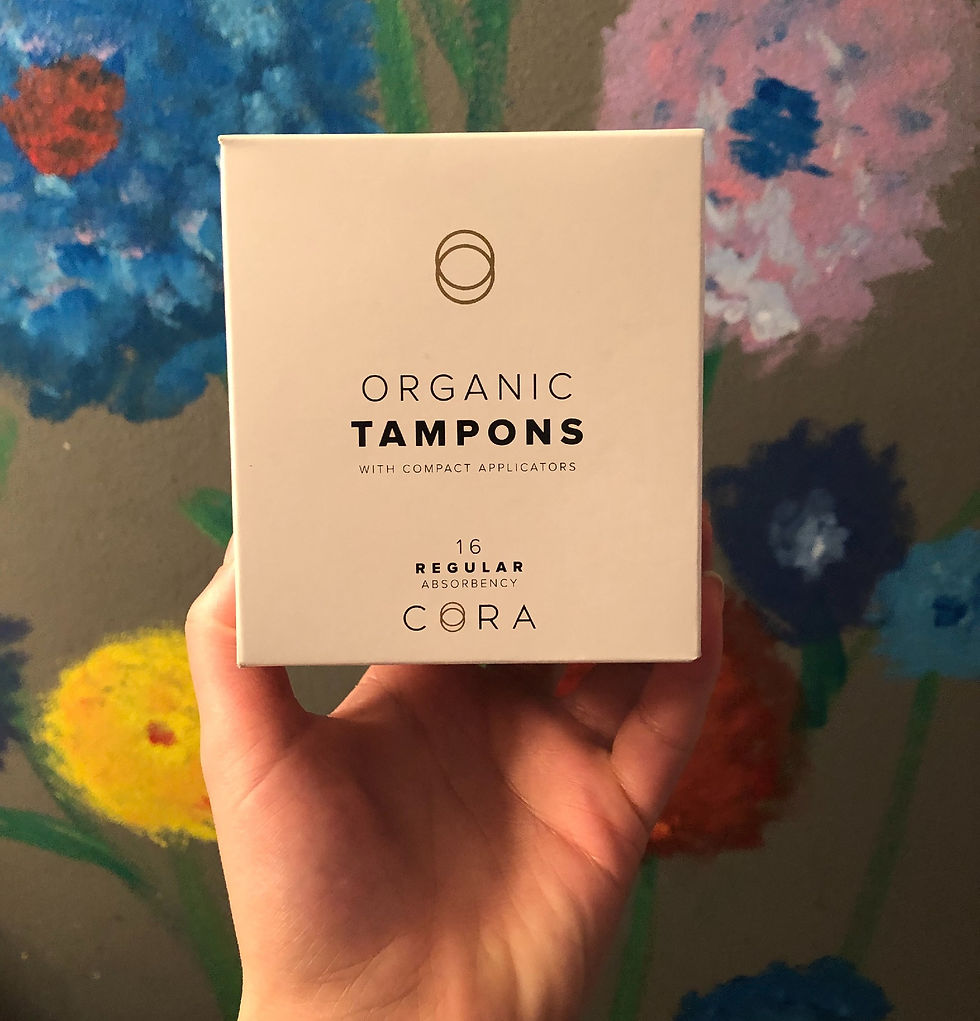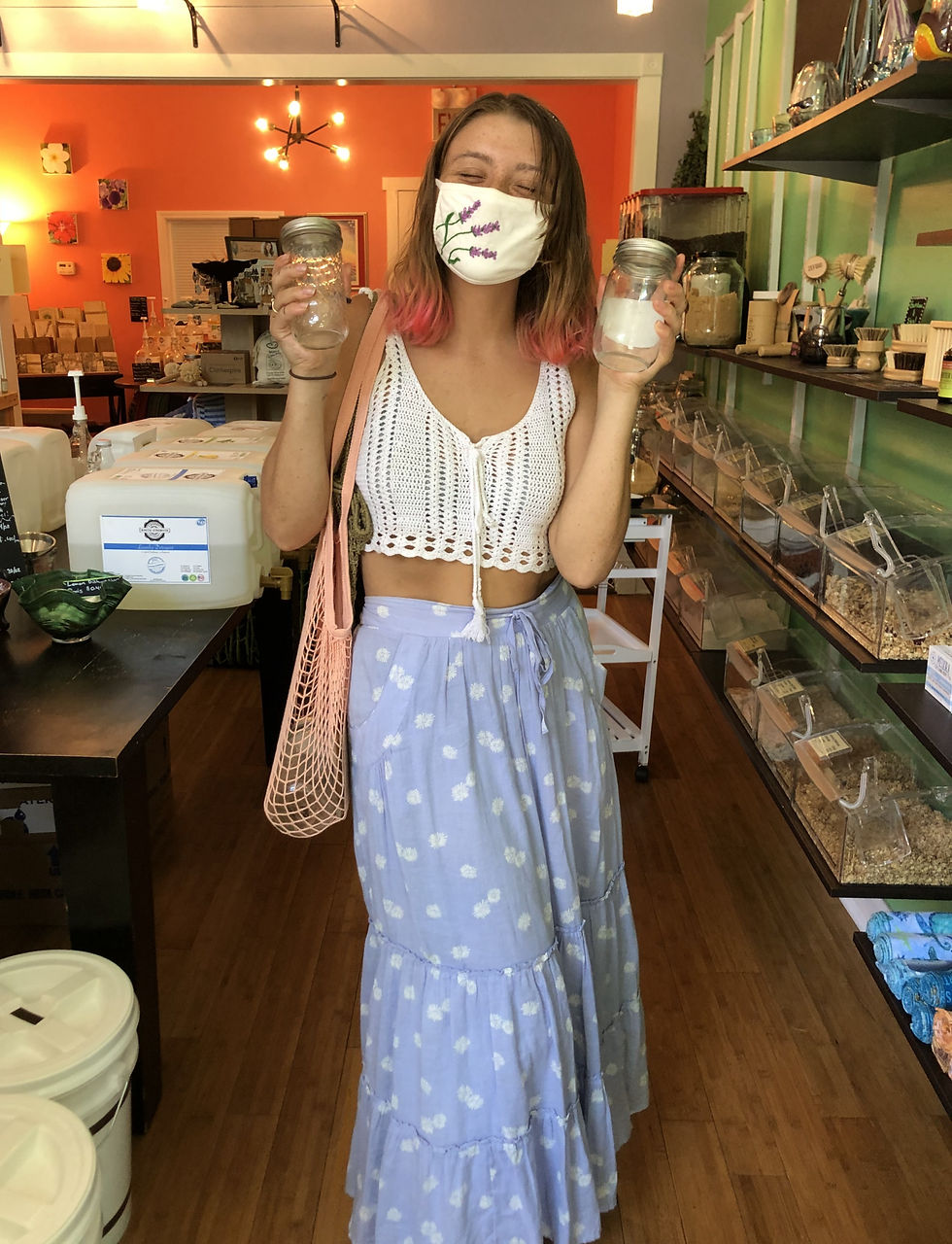disposable products must go, period.
- julia

- Jan 10, 2019
- 6 min read
Alright, if talking about a completely natural function of the human body makes you uncomfortable I suggest one of two things: 1) Click away. 2) Grow up.

It is time for me to admit that I, despite being extremely vocal about how disposable products are pretty much the worst, have still been using tampons. I have been nervous for too long about trying a menstrual cup because it is something totally new to me (I remember how long it took me to get comfortable enough to start using tampons instead of pads, yikes). But after reading, researching, and taking a quiz to help me find the cup best fit for me, I finally ordered one.
(Put A Cup In It had a great quiz, tons of information about cups, and comparisons of sizes and brands.)
Surprise, surprise, I am absolutely in no shape or form an expert on menstrual cups, or even periods for that matter (even though I have been dealing with it for nearly a decade). But hopefully after you read this you can work up enough courage to go get your own cup and we can figure this out together!
As I said, I took a quiz and it matched me with a couple of cup options - Lunette, Model 2 and Saalt, Regular - but in the end I decided to go with Lunette, Model 1, which is a little softer and smaller than Model 2.
Now, I was using anywhere from 3-6 tampons a day, my sister says something similar, give or take a pad, and my mother says the same. Take that times the average period length of 5 days, that's about 25-30 tampons/pads used in just one cycle. 11,000 pads and tampons later and we've got hundreds and hundreds of pounds of garbage.
So, not only do disposable period products create a bunch of waste, but it gets better...They're full of toxins too!!!
Probably the most common (and harmful) ingredient in tampons is rayon. This is a semisynthetic material used in the core of the tampons because it is pretty similar to cotton, except for all the harmful things that come along with it. As it "breaks down" it releases carbon disulfide, a colorless and poisonous liquid that can cause nausea, fatigue, headaches, and more. Long term exposure to carbon disulfide can also lead to neurological and reproductive problems.
Rayon tends to be bleached using chlorine, and I don't know about you, but that is not something I want INSIDE my body. (No matter how small of an amount it is.)
Another common ingredient is polyethylene - which is not particularly terrible for you with direct usage, but it is the same type of plastic that is used to make things like grocery bags and shampoo bottles.
Tampons applicators are (would you believe it) made of plastic as well, but at least there are slightly better alternatives, such as cardboard or none at all.
Pads are not much better, they can contain up to as much plastic as four grocery bags. (You should know all the issues with plastic bags by now) The absorbent foam used as the core of the pads, plastic. Wings, plastic. Wrapper, plastic.
I now realized that I was just turning a blind eye to the terrible impacts regular period products have on my own body and the environment and am happy to have finally started to switch over to more sustainable options.

December 31, 2018
Ordered the Lunette Menstrual Cup from Amazon.
January 5, 2019
The Lunette Cup came in a cardboard box, with (thankfully) no additional packaging or wrapping inside. I was disappointed to see that there were windows on the box, because these are usually made of plastic, but on the back it did say that the whole box was compostable, which was a pleasant surprise.
Instructions say to boil the cup for 20 minutes before you use it for the first time so I did this right away.

I did purchase some tampons in the event that using the cup did not go quite right at first. I chose CORA Organic Tampons, priced at $5.99 for a box of 16 regular tampons. Although more expensive than the popular brands, like Tampax or Always, these are free of toxins and will break down without releasing them.
CORA offers a variety of sizes of tampons and pads that you can purchase online, in individual boxes or with a subscription, and they are also now carried at Target. (Another good brand is L. - also found online or at Target.)
Day 1
Got home from work and my period started late that day, thankfully. Decided to go right for it and try out the cup. Managed to get it on the second try, but it is definitely something to get used to. I didn't feel it once I adjusted it a little bit, but did have to fix it after about an hour or so because it was sitting too low and was pushing on my bladder. After that, all was well and good, emptied the cup after a few hours, just before bed. I know there will be a huge learning curve here because not only was it kinda difficult, but also a little painful.
Day 2
I am assuming the cup shifted as I slept so I did wake up to a small amount of leakage, but wasn't particularly surprised. I had heard/read that changing the cup in the shower was the way to go, which makes sense, so I wanted to give that a shot. Although the "mess" was completely contained, trying to get the right angle to get it out was significantly more difficult. I made the decision to take a little break from the cup, so I opted for a tampon for awhile. Tried the cup once more and everything was good for the rest of the day.
Day 3
As I was getting ready for work I was wearing the cup, but I couldn't get it quite right. It was not painful, but I could feel it and so at the last minute I went for a tampon yet again. I was frustrated that I had to do this, but knowing myself, if there had been an issue or leak I may have gotten more discouraged and given up. I think at this time I made the right decision.
I took a ballet class later on in the day and wanted to see how the cup held up with more/different types of movement. Overall, I was pretty pleased, no shifting or leaks whatsoever, which was quite wonderful because I have lost count of how many pairs of pink tights that have been ruined to do that exact issue.
Day 4
Didn't bother to wear the cup to bed on night 3 because I rarely have any blood overnight at this point in my cycle. I put the cup in late morning, with very minor leakage after about an hour or so. I'm still not exactly sure what the issue is with leaking, it could be it was in wrong or it may just be one of the drawbacks of a menstrual cup. In the future I may look into cloth liners or something of that variety to catch anything. Changed my cup once late afternoon, wore it for a few more hours and took it out before bed.
Day 5
Last day! Put the cup in before I left for work and had no issues all day.
Convenience: ✩✩✩✩
For convenience I gave the menstrual cup a 4 out of 5 because it was super nice to not have to worry about it every couple of hours like I would have to for a tampon. BUT - if you are out and about and need to empty it, it is a little trickier unless there is an available single-stall bathroom.
Cleanliness: ✩✩✩✩
For the most part, except for the few minor leaks, I felt very clean. Although, it would be hard for me to say if changing it is cleaner that a tampon. If it spill somewhere other than the toilet, then yes, that may be an issue. But overall it really was not particularly messy or difficult to empty and rinse.
Comfort: ✩✩✩✩
If it is in right (and you have the right size) there shouldn't be any problems. I only had issues as I was figuring out how it fit. Like I had said, it was too low and so it pushed on my bladder and the stem stuck out, but after fixing it, I couldn't feel it.
Ease of Use: ✩✩✩
This is definitely not a product that is going to work perfectly right away, but after a few times I know it will get easier and easier.
I am extremely pleased with my first experience with a menstrual cup and although I am not anxiously awaiting my next period, I am happy that I have a better alternative to use when it does come.
Would I recommend? Definitely.
xoxo











Comments